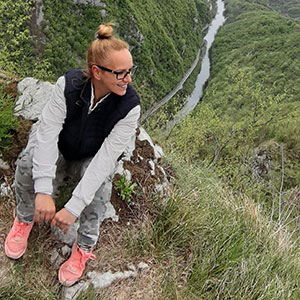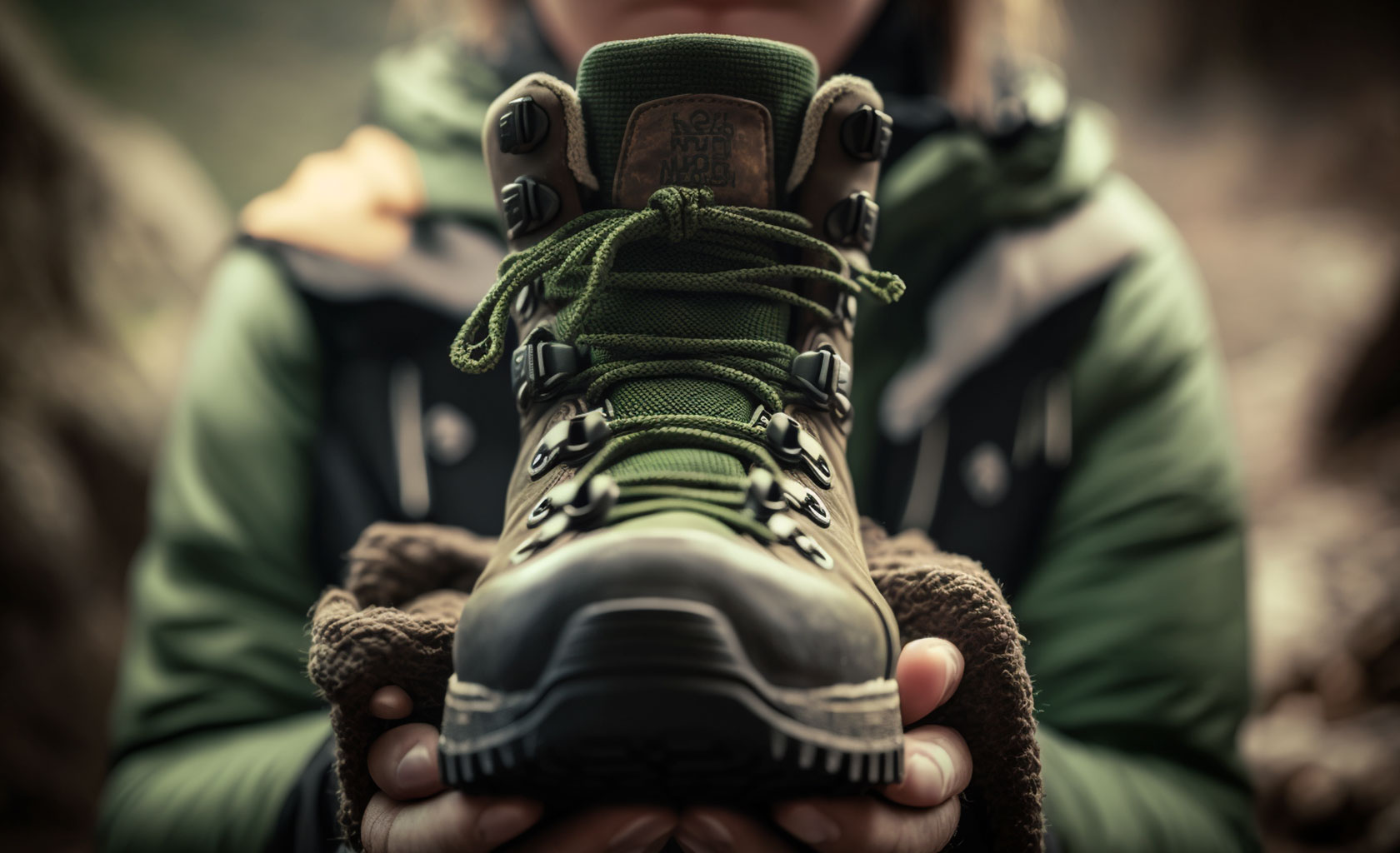Hiking boots are probably the most durable and the most reliable piece of hiking equipment. They are a sturdier, tougher and safer choice compared to hiking shoes or trail runners. But what is all the fuss about the best hiking boots for women especially? Women do not hike in high heels, ok, so is there actually a need for this selection? To keep it simple, this list exists because gender really has a say in the production of hiking boots for women and men, separately. This is to say that women do need different hiking footwear than men do. So, once we have this settled, we give you our top 5 picks and review of the best hiking boots for women in 2023, along with basic buying advice.
QUICK PEEK
- Best hiking boots for women overall – Altra Lone Peak ALL-WTHR Mid 2
- Close second choice – Salomon X Ultra 4 Mid GTX
- Best budget hiking boots for women – Merrel Moab 3 Mid
- Best cushioning in women’s hiking boots – Hoka One One Anacapa Mid GTX
- Favorite hiking boots for women with narrow feet and deeper pockets – La Sportiva Nucleo High II GTX
1. BEST HIKING BOOTS FOR WOMEN OVERALL - ALTRA LONE PEAK ALL-WTHR MID 2
Pros: Highly lightweight. As comfortable as hiking boots can be. Extremely well cushioned and highly grippy.
Cons: Potentially lower durability than some others on our list.
Their durability is not the highest ever and yet we decided to put these on top of our 2023 best hiking boots for women list. How is this possible? Well, other benefits of these hiking boots simply blew us away. To start with, Altra Lone Peal ALL-WTHR Mid 2 are extremely lightweight and insanely comfortable. No break-in whatsoever is required, which is equal to wonder in hiking boots. Also, their ankle support is first class and the soles are sufficiently grippy. Lastly, they are waterproof (eVent technology, similar to Gore-Tex) and have a wider toe section which allows for additional comfort. Hiker’s tendons could not wish for a better boot.
Let’s make things clear once more. We love these Altra Lone Peak ALL-WTHR Mid most because they are innovative and unconventional. This is to say they provide the comfort of trail runners, but do not drastically lack any other quality of hiking boots. They offer padded ankle support, great lugs, reliable lacing for stability, and perfectly good traction. These hiking boots might not be as durable as their counterparts on our best hiking boots for women list, but the feeling you have wearing them will compensate for it all.
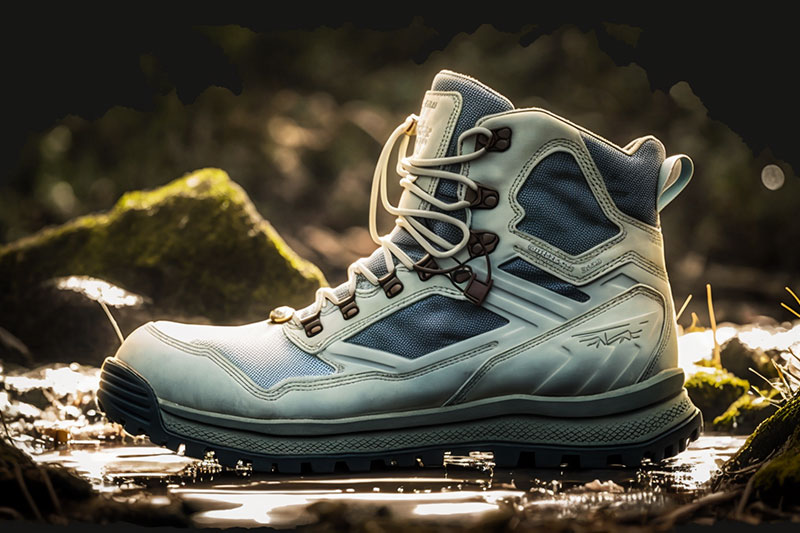
2. SALOMON X ULTRA 4 MID GTX - CLOSE SECOND CHOICE
Pros: Traditional reliability, exceptional toe and ankle protection, low weight.
Cons: Not as comfortable as our first choice.
Women love Salomon X Ultra 4 Mid GTX. These hiking boots have it all – modern but protective design, supportive soles, stable lacing, exceptional ankle support, and are waterproof of course. They are sturdy but comfortable and offer a sensation of being well protected. Above all, Salomon X Ultra 4 Mid GTX are light. They weigh only 1 lb 10.1 oz, which is just 4.1 oz more compared to the lightest boots on our list. This is to say that wearing these boots will not exhaust your feet. Also, no other hiking boot manufacturer has such proven consistency in producing highly durable and reliable yet modern and appealing footwear. With their sufficiently wide toe box and lugs that can cope with all weather conditions, Salomon X Ultra 4 Mid GTX probably make the most reasonable choice when it comes to hiking boots for women.
Yet, we put them in the second place. This is because they are not as comfortable as Altra Lone Peak ALL-WTHR Mid. Keep in mind, however, that Salomon X Ultra 4 Mid GTX do feel good to wear, particularly compared to many other rougher hiking boots on the market. It is just that they are more rigid than the first boots on our Best Hiking Boots for Women list.
3. MERRELL MOAB 3 MID - BEST BUDGET HIKING SHOES FOR WOMEN
Pros: Excellent combination of price and quality.
Cons: Slightly heavy and less comfortable than the competition.
Irrespective of the number standing after the name, Merrell Moab is what experienced hikers call oldie but goldie. So, if you are after a good and reliable hiking boot with low price and uncompromised quality, you have just found yourself the best hiking boots for women. As stated above, Merrell Moab 3 Mid probably have the best price-to-quality ratio on the market. These boots are durable and tough built but are also easy to break in. Their meshes provide substantial breathability. A waterproof version is available too. In addition, their cushioning is more than fair and the ankle section and tongue are well-padded. All in all, an excellent hiking partner for all those who want to overpay quality.
The only substantial drawback of these hiking boots is their weight. They weigh 1 lb 13 oz which makes them the heaviest hiking boots on our list. We would not recommend these for big-mile hikes. This, however, does not mean that they are not a good choice. On the contrary, if you do not mind some extra weight on your feet and generally take day hikes, Merel Moab 3 Mid are the best hiking boots for women you will ever find.

4. HOKA ONE ONE ANACAPA MID GTX - BEST CUSHIONING IN WOMEN’S HIKING BOOTS
Pros: Cushioning, fit and comfort.
Cons: Not as durable as some competitors. Look chunky.
This choice could come as a surprise for you but know that these hiking boots surprised us as well. As a traditional producer of running footwear, Hoka shook the hiking world once more. With Hoka One One Anacapa Mid GTX they managed to produce hiking boots for women with the best cushioning ever. Their elastic midsole, curved design and strong construction enable easy and no-stress movement of your feet. Wearing them makes you feel safe and light. Also, Hoka One One Anacapa Mid are waterproof, due to the combination of strong leather and Gore-Tex lining. They are super supportive and have a high-performing lacing system, favored by all those who like to loosen up their boots.
When it comes to drawbacks, there are only a few, we believe minor. With their high-performing Eva soles, they seem chunky. So, from a visual point of view, Hoka One One Anacapa might not be everyone’s first choice. Also, like many other extremely comfortable newly designed hiking boots, they lack durability. Finally, a slightly better grip on even technical surfaces would be preferred. Other than that, these would be the best hiking boots for women who prefer cushioned feet over price and durability.
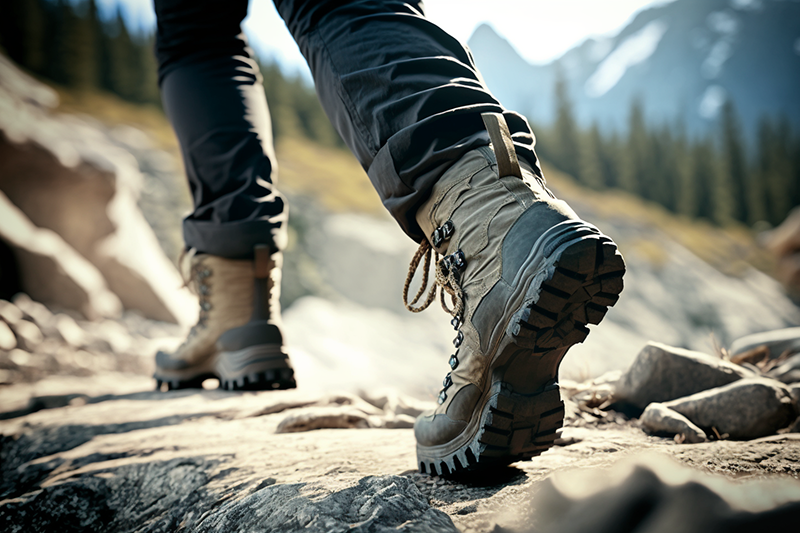
5. LA SPORTIVA NUCLEO HIGH II GTX - FAVORITE HIKING BOOTS FOR WOMEN WITH NARROW FEET AND DEEPER POCKETS
Pros: Astonishing weight-to-protection ratio. Beautiful breathability.
Cons: Price
La Sportiva Nucleo High II GTX are true hiking boots. This means they are strongly built and highly protective. They are waterproof, have good ankle and arch support, stable lacing and fair cushioning. But all these qualities are not what made us put it on the list of best hiking boots for women. It is a fact that all these qualities come with a low weight. Weighing only 1lb 6 oz. a pair is almost a miracle for standard leather hiking boots. In addition, La Sportiva Nucleo High II GTX have one more remarkable quality that makes them stand out among completion. Their breathability goes both ways. This means that both, the upper and the bottom side of your feet will easily breathe thanks to Gore-Tex Surround.
However, all these benefits come at a price. La Sportiva Nucleo High II GTX are the most expensive hiking boots for women on our list. Also, unlike the great majority of standard leader hiking boots, they are narrow. Yet, if you happen to be a woman with narrow feet, this is not going to be a drawback, but rather a reason to spend some extra money for a perfect fit.
COMPARISON TABLE
A careful customer, as we would like you to be, will always consider the price of a product when making a purchase. That is why our comparison table lists the best hiking boots for women based on their price. The following columns show weight, our rating and the reasons for which we rated them as above.
| Name | Price | Weight | Our rating | Reason |
| Merrell Moab 3 Mid | 120 $ | 1 lb 13 oz | 3 | Reliability at low cost. This does not happen often in the world. |
| Hoka One One Anacapa Mid GTX | 148 $ | 1 lb 12 oz | 4 | Turn rocks into clouds. More durability would be preferred. |
| Salomon X Ultra 4 Mid GTX | 175 $ | 1 lb 10.1 oz | 2 | We have not yet met a girl who regretted buying these boots. Durable, tough and instantly comfy. |
| Altra Lone Peak All Weather Mid 2 | 190 $ | 1 lb 8 oz | 1 | A perfect blend of the highest comfort, low weight and an astonishing overall performance. |
| La Sportiva Nucleo High II GTX | 239 $ | 1 lb 6 oz | 5 | Beautiful high-performing boots. We love them despite the price. |
BUYER’S GUIDE - THINGS TO CONSIDER WHEN BUYING HIKING BOOTS FOR WOMEN
Let’s open up this section of our best hiking boots for women review by underlining a simple truth about women. Women are different than men. And we are not talking about feelings, mentality or habits here. We are talking about feet, weight, tendons and bones. In essence, we are talking about hormones and the way they induce different physical qualities of the sexes, beyond aesthetic and reproductive. So, if you are in for more info on how and why is female hiking footwear different than male, read our article here. If not, just adopt this consideration as a fact and move forward to buying advice below.
Weight
Weight is an important factor to consider when finding the best hiking boots for women. Until quite recently, more weight in hiking boots for women necessarily meant more stability. And tender female tendons love stability. Nowadays, however, with the breakthrough of trail runners into the hiking world, weight is beginning to lose the positive connotations it used to have. The lighter the better – you can almost hear it as a chant all over the internet.
We cannot argue that low weight is not preferred. It is. However, when thinking about the weight of the best hiking boots for women, you have to ask yourself 2 simple questions.
- How has such low weight been achieved, and
- What has been compromised to achieve the low weight?
Otherwise, the lightest hiking boot would implicitly be the best one and things would just be too simple.
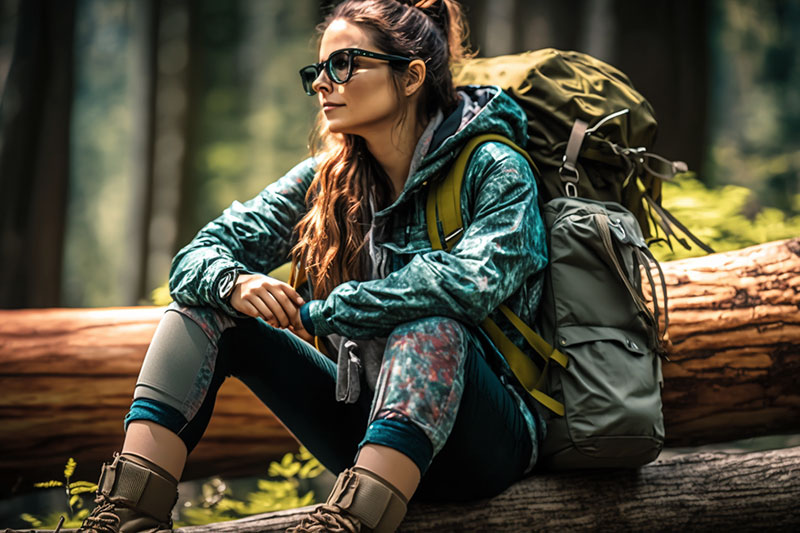
Lightweight hiking boots for women
Producing the best hiking boots for women today means cutting down on weight as much as possible without excessively compromising any other must-have feature, such as stability, durability, waterproofness and overall protection. Such safe reduction of weight is most often provided by materials.
So, a lightweight hiking shoe for women will generally have synthetic materials, meshes often combined with leather, synthetic membranes to secure waterproofness and flexible EVA soles. These qualities make lightweight hiking boots fast, elastic, comfortable and sufficiently protective meaning that they do indeed provide more protection than the trail runners they originate from. This makes them excellent partners for light backpacking and daily hikes. For example, with their 1 lb 8 oz, Altra Lone Peak ALL-WTHR Mid from our list stand out as an outstanding representative of the category. However, it is fair to say that, lightweight hiking boots for women generally lack stability and durability that sturdier midweight hiking boots provide with ease.
Midweight hiking boots for women
This category of the best hiking boots for women is often called “all-around hiking boots”. The nickname indicates a difference beyond weight – these boots weigh slightly more but perform remarkably well under any circumstances. Truth be told, this is not the case with the majority of lightweight hiking boots which do not handle rocky surfaces quite well.
Fun fact is that some hiking boots, such as La Sportiva Nucleo High II GTX or Salomon X Ultra 4 Mid GTX have extremely low weight but still belong to the all-around category. This is because of the tight-in feeling they provide. Their weight may be low, but the level of safety and structure they provide is not. The best hiking boots for women from this category also have stiffer midsoles, often TPU shanks and generous toe caps. The majority of hikers choose boots from this category.
Highweight hiking boots for women
Here, we have typical hiking boots that are most concerned with safety and protection and do not easily compromise any of the two for a softer step. Unpopular as weight may be, there are still some perfectly good examples of highweight hiking boots that do provide a good balance of the qualities above. Arc’teryx Acrux TR GTX are such boots. With their 2 lb 1.2 oz, they manage to offer remarkable comfort that goes hand in hand with the famous Arc’teryx built-to-last quality. These boots feature leather uppers and TPU supports and chassis.
However, none of the boots from our Best Hiking Boots for Women list are heavyweight. There are two reasons for this:
- None of the hiking boots weighing more than 2 lb can boast of such an outstanding quality that would, in our minds, reasonably compensate for the difference in weight.
- We purposefully do not make our lists extensive because we do not want to you to wander around and lose time. We want you to find a good piece of hiking footwear and go for a hike.
If, however, you do not mind wearing some extra pounds on your feet, we recommend you consider Arc’teryx Acrux TR GTX above or Zamberlan Vioz GTX. Both are well-deserving of your time, attention and money. Also, check the weight-related details given in our general review of Best Hiking Boots in 2023.
Waterproofness
By definition, waterproofness is the ability of a particular product or material to repel water. The overall aim of the game is to keep the water out and your socks and feet dry. In this context, the best hiking boots for women do not differ from their male counterparts. The same materials are applied to secure the quality – Gore-Tex membrane, or a similar in-house version such as with Keen.dry and water repellent coating acting as an additional safety lock, particularly with leather uppers. So, look for these in product specifications. That is if you actually need waterproof boots. Which many among you don’t.
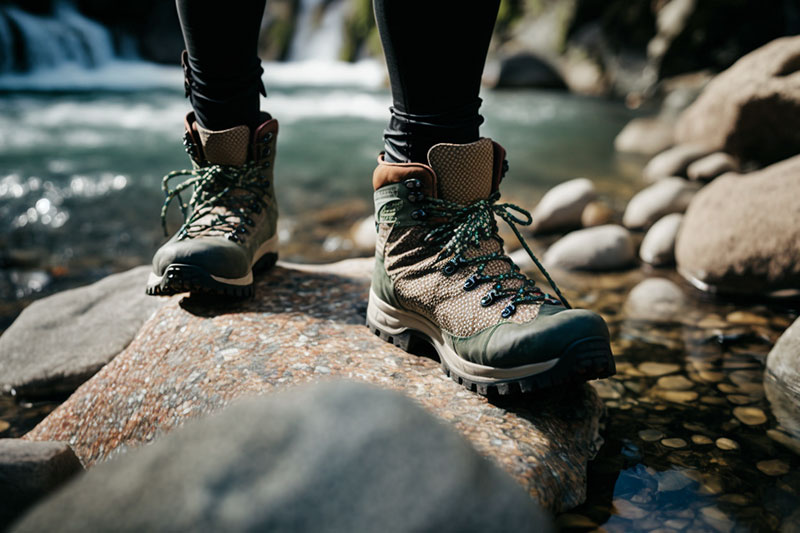
It would be only too easy to end the waterproofness story a simple advice such as “Look for Gore-Tex”. The thing is that this membrane, along with other similar ones, does such a great job at preventing the water to go through that it also blocks the transit of air. Not completely but to a considerable extent. This means that once your feet get sweaty, which they inevitably will, it will become difficult for them to dry off. For this reason, we highly recommend you think carefully about whether you actually need waterproof hiking boots. If you mainly hike in dry weather, or when it is not too cold outside, waterproof membranes might become more of a burden than a benefit. Remember, they also add up the weight and the cost.
Breathability
Considering how the waterproofness of hiking footwear is provided, breathability becomes an almost completely opposite feature. As if the two were mutually exclusive. Which they are, again to a considerable extent.
Namely, no waterproof boot is 100% waterproof. The billions of pores in the membranes as tiny as they may be still exist and remain open. This means that if you dip the boots in water and let them stay for a while, some water will inevitably penetrate inside. Along with some air.
So, despite what declarations might claim, full breathability is only possible in nonwaterproof boots such as Merrel Moab 3 Mid. This means that your feet will get wet but will have the opportunity to dry off. However, various types of waterproof boots allow for different levels of air ventilation. For example, heavyweight leather boots with Gore-Tex membranes do not perform well in this context. Yet, our number 5 on the list, La Sportiva Nucleo High II GTX, breathes remarkably well with their heavy meshes and Gore-Tex Surround. eVent upper of the Altra Lone Peak ALL-WTHR Mid 2 also breathes much better than the competition.
Traction
Along with the upper structure of a hiking boot, traction has a lot to do with stability i.e. how safe and firm you feel when stepping on a specific surface. In essence, traction means friction – the more friction is caused between the surface and your foot, the less likely it is that you will slip or fall. Two factors determine traction: lugs and outsoles.
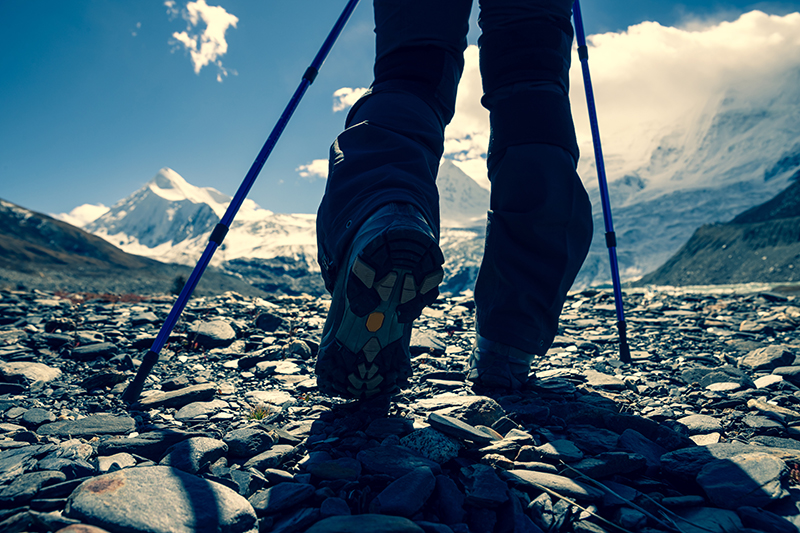
Lugs
People often make mistake by not looking at lugs separately from the soles. Lugs are an extension of the sole but their purpose is not just to provide a barrier between the surface and the foot. They handle the pressure of the hiker’s weight and transfer it to the ground, increasing thereby friction and preventing slippage.
When looking at lugs, as a hiker, you should consider depth and shape. Deeper lugs generally are better for more demanding terrains such as snow, mud and rocks. If your hikes tend to be this difficult, opt for a V-shaped and Z-shaped lug pattern. Also look for prominent lugs in heal section, so-called heal breaks.
At the same time, slightly shallower, rounded lugs in different shapes and patterns, known as mixed thread lugs, are good for gravel, grass and dirt.
Outsoles
Outsole is the outermost layer of the sole, the foothill of the lugs. Similar to lugs, its function is to provide traction but also to secure durability. For this reason, the main concern with the outsole is not the shape but the material. So, if you want to buy a hiking boot that lasts and performs, look for rubber. i.e. harder and softer rubber compounds. These are resistant to water and abrasion, cope quite well with all types of surfaces and guarantee durability, flexibility and excellent traction.
Vibram is the name you will often hear in this context. The name is almost a synonym for a good rubber outsole. Be aware, however, that Vibram is not one specific rubber compound, but a brand producing highly reliable outsoles. The reputation it enjoys is more than well deserved.
Comfort
Best hiking boots for women are tough but must be as comfortable as possible. This feature is difficult to define as it depends on too many variables, including hiker’s individual preferences. However, it is safe to say that midsoles and uppers play a key role.
Midsoles
The trouble with midsoles is that they are invisible to the human eye. They are sandwiched between the outsole and the insole. So, the only way to inspect them is to perform a pressure test – put the boots on and apply pressure by standing on one leg only. The midsole should provide specific resistance but also absorb the impact of your weight, making you feel stable and comfortable along the way.
Materials are the key players in securing that midsoles fulfill their function properly which is to provide cushioning, support and stability. The best performers among these are EVA, TPU and the combination of the two. Specifics are given below.
EVA – Ethylene-Vinyl Acetate foam, extremely lightweight and flexible, provides excellent shock absorption, relieves your feet and joints from the impact of walking on uneven terrain, has excellent insulating properties (keeps your feet warm) and promotes free and light movement. As such, EVA midsoles are excellent for light backpacking and day hikes on moderate terrain. The drawbacks of this material are that it lacks the durability and stability of the TPU. For this reason, lightweight hiking boots are more prone to damage than their mid and heavyweight sisters.
TPU – Thermoplastic Polyurethane, extraordinarily durable and supportive, provide maximum stability, water resistance and responsiveness. TPU soles will last longer than EVA, they perform better on demanding terrains and have a higher rebound rate compared to EVA foam, offering more energy return with each step. These midsoles are great for backpacking, challenging terrains and multi-day hikes. Compared to EVA, it weighs more and lags behind in flexibility.

Uppers
Uppers are important. They define the looks, which have to be appealing at least to a specific group of people, women in this case, but also govern waterproofness, stability and comfort.
What the uppers do and how well they perform mainly depends on the materials they are made of. The best hiking boots for women, and men, will have uppers made of leather, mesh and nylon. Individual properties of these materials impact the boot’s performance. And here we go.
Leather – full-grain leather is the oldest, toughest and most durable uppers material. It lacks breathability but will outlive its entire competition at any time. Suede and nubuck are lighter and breathe better, with nubuck being the more resilient one, as it is made of the outer layer of animal skin.
Nylon and mesh – considerably lighter and more breathable than any type of leather. They dry off very fast and offer substantial durability. Synthetic uppers do not adapt to the shape of your feet as well as leather uppers do, but offer great fit and comfort.
A combination of two (or three) often gives astonishing results, as is the case with Merrell Moab 3 Mid and La Sportiva Nucleo High II GTX, number 3 and number 5 on our Best Hiking Boots for Women list.
Lacing
Among all other hiking footwear, hiking boots have the highest cut. This translates to the longest laces.
If you have read our general review of Best Hiking Boots for 2023, you already know we are fans of a traditional lacing system. Particularly with boots. So, although there are some quite remarkable Quicklace representatives on the market (Salomon mainly), we still prefer the reliability of holes and hooks. Our stance on the matter is not entirely subjective, however. It is only a fact that standard lacing allows for a more efficient adjustment of the boot to accommodate the hiker’s personal needs. This impacts comfort heavily. And since lacing is comfort’s final touch, there is really no need for it to spoil the game at the very end of it.

Toe protection
All hiking boots on our list have the toe caps on – the rubber bumpers at the top of the boot. The only question is how big the bumper is. Some manufacturers decrease it substantially with aim to cut down on total weight. Others stay on the safe side and feature prominent toe caps, being aware that, one way or another, you will eventually kick a rock or stone with your thumb.
Luckily enough, unlike with midsoles, toe caps are visible. This simplifies the matter a lot. If you are safety-oriented, opt for bigger toe caps. If, however, you consider yourself a more agile type that does not hit objects frequently, chose less prominent toe protection. The choice is, as always, yours, my ladies.

